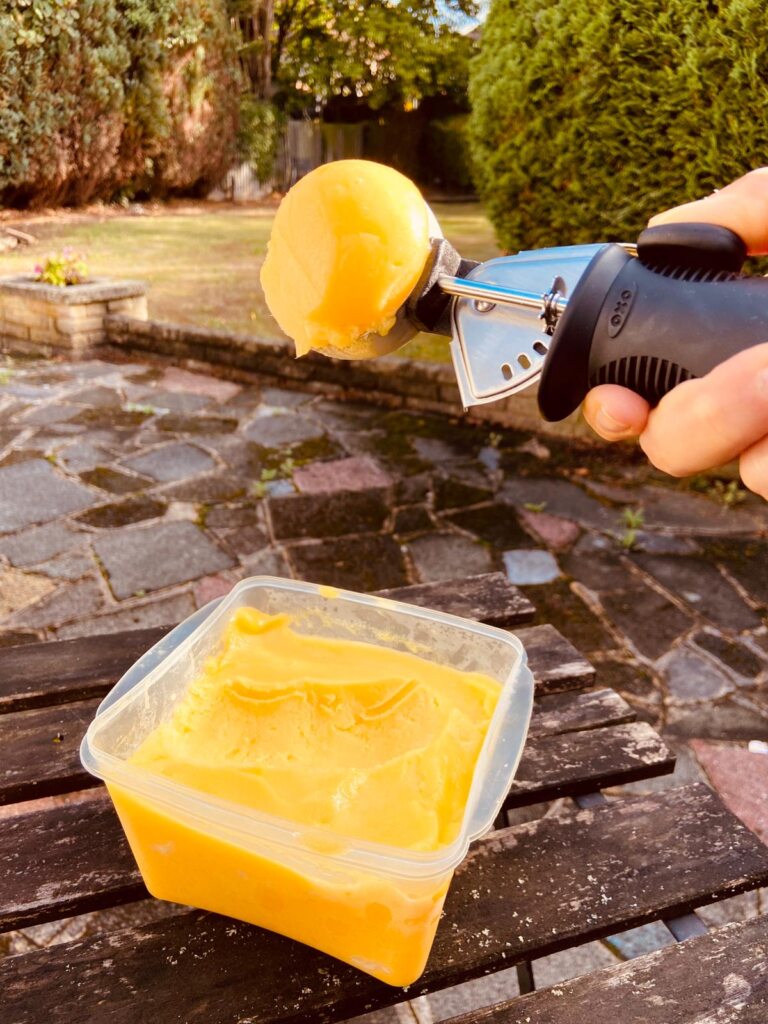I have this clear memory of living in Caracas, I couldn’t have been more than 3 or 4 and my mother had brought back from the market a massive mango, it was so big that I couldn’t get a hold on it. My mother went on to slice off each cheek and hand one to each of my brothers, being the youngest I was left with the sides and my mother got the flesh that was left on the pit. I felt I was cheated! I wanted one of the cheeks, cut into squares, and then turned out so each one resembled a porcupine. I always felt cheated in the mango department, that was until years later. We were living this time in Rio de Janeiro and on my way to ballet there was an ice cream vendor selling mango sorbet, I can’t remember ever tasting something so ethereal, I took ballet for nearly two years, which is exactly two years longer then I think I would have, had it not been for the mango sorbet.
Sorbet is something I started making when we moved to Israel in the late 1990s. Between the heat and the amazing array of fresh fruit, it became natural to make sorbet almost weekly. Without an ice-cream churner, I started using my food processor to make the frozen fruit puree into a creamy sorbet. Every week I would look for a new fruit to use in my weekly sorbet concoction, the secret to good sorbet I learned early on, is good fruit, your sorbet will only be as good as the fruit you are using. Use our recipe below as a template, and allow your imagination along with what is available in the market to guide your sorbet creations.
WHAT IS SORBET? In my opinion the food of the gods – seriously refreshing, tangy, and sweet, I’m pretty sure I could happily eat sorbet every day for the rest of my life. That is the homemade stuff, with the perfect balance of sweet and tart. Here is the thing, sorbet if it has too much sugar, will be too sweet and won’t freeze correctly, too little sugar and the sorbet will be icy and hard. On average we are looking for 2 parts fruit juice or puree to one part sugar, and there is a fun way to test the amount, see below.
HOW TO TEST FOR SUGAR IN SORBET: it’s important to know that you have enough sugar in your sorbet so it will freeze correctly. Here is how you test. Place the fruit puree in a large measuring jug and place a clean raw egg (IN ITS SHELL) in the mixture, it should sink (mango puree is very viscous so not so much sinking going on – but in general this works) remove the egg from the puree. Add about ½ a cup of the syrup to the puree and now add the egg again, keep on adding and testing with the egg until the egg floats to the top, you should see just the very top of the egg peaking through the fruit puree. Now you know you have enough syrup, it is time to test for sweetness, does it need more sweetness or more tartness?
WHAT SHOULD A SORBET TASTE LIKE BEFORE IT FREEZES? You want your sorbet to be ever so slightly sweeter than how you would expect the frozen mixture to be. Once frozen the sweetness is dulled just a bit. And yet at the same time, you want to make sure that there is a tartness and zing to your mix, so keep on adjusting the flavor by adding a bit of sugar water and balancing it with a bit if acid until you reach a mixture that is slightly sweeter than you want but still has a zing.
IF YOU DON’T HAVE AN ICE CREAM MAKER still make this recipe, I had been making sorbet for years before I finally invested in an ice cream maker, and sorbet, unlike ice cream, will set up perfectly, as long as you have a food processor. What to do? Once you have your sorbet mix, pour it into a baking tray lined with baking paper and freeze for a couple of hours. Once the mixture is frozen. Cut the frozen mixture into blocks and process in the food processor, incorporating air and breaking up the ice crystals. Refreeze the mixture on the tray a second time, and then after another 2 hours, repeat the food processor stage. You now have a perfectly smooth and airy sorbet.
NOTE ON SUGAR SYRUP; sugar syrup is something I keep in my fridge throughout the summer, obviously great for making sorbets, but also my go-to sweetener for iced coffee, iced tea, and lemonade, as the sugar is dissolved and will mix into drinks far more easily. Make a big batch and store it in the fridge until you are ready to use it.
SORBET IS ONLY AS GOOD AS THE FRUIT YOU USE if your fruit isn’t perfectly ripe and delicious, sadly with a sorbet there is nowhere to hide. Your starting point for sorbet making is actually the market, what is in season, what is abundant, that is what will make the best sorbet, once you have delicious fruits to work with your sorbet will be delicious.
IDEAS ON FLAVORS use the recipe below as a template for any sorbet, in conjunction with the egg test you are on your way to an amazing world of frozen treats. Think Strawberry, Passion fruit, lemon, cherry, orange, plum, apricot… you get the picture. Keep in mind that if the fruit lacks tartness and you are about to add quite a bit of sugar have some citrus on the ready to boost the acidity of the mix.
TO SIEVE OR NOT TO SIEVE this is up to you, do you want a super smooth finish, or would you prefer a bit of texture. The way I decided is that I make the fruit puree, and taste the result, and then decide what way I’m going to go. Just like the best sorbet flavors aren’t decided until you get to the market, so to the texture shouldn’t be decided until you have tasted and experienced the mouthfeel of the puree.
THE BEST TIME TO CHURN YOUR SORBET though not essential, the best time to churn your sorbet is on the day you plan on serving it. Make the fruit puree mix up to 3 days ahead and store in the fridge, and if possible churn the puree several hours before you plan on serving it. If my plan is to serve sorbet on Shabbat lunch I tend to churn it Friday afternoon before Shabbat. Though this is a guideline it’s not strictly necessary. That being said I would suggest that the sorbet once made be frozen (obviously) and served within 3 days of being churned for the best possible taste.
- 2 cups granulated sugar
- 2 cups water
- 3-4 ripe mangos, peeled and cut into chunks
- 2-3 limes
- Make Sugar syrup: Put the sugar and water in a medium saucepan. Place over low heat to dissolve the sugar, using a spoon gently stir to prevent the sugar from sticking to the bottom of the pan. Once the sugar has dissolved, turn the heat up and do not stir. Bring the syrup to the boil and boil steadily for 5 minutes. Take off the heat, cool, and keep covered until needed. Sugar Syrup can be made up to a month ahead of time and stored in the fridge.
- Place 3 of the 4 mangos in the food processor along with the juice of 1 and a half limes, and process until you have a fine fruit puree. You are aiming for 830ml (3 ½ cups) of fruit puree in total (If you are planning on sieving the fruit, the volume if after you have passed the puree through the sieve).
- Add the sugar syrup to the fruit puree, half a cup at a time and check for sugar density with a raw egg, once you have reached the right amount of sugar to ensure the sorbet sets just right; now it is time to adjust the taste.
- Add more sugar water or lime juice as needed, to achieve a slightly sweeter mix then you think you would like, and yet enough lime juice to ensure that the mixture is zingy.
- Refrigerate for 2-3 hours or up to 3 days. Before adding the mixture to the ice cream maker to churn. Once your sorbet is churned, place in the freezer for 30-50 minutes to set up.


